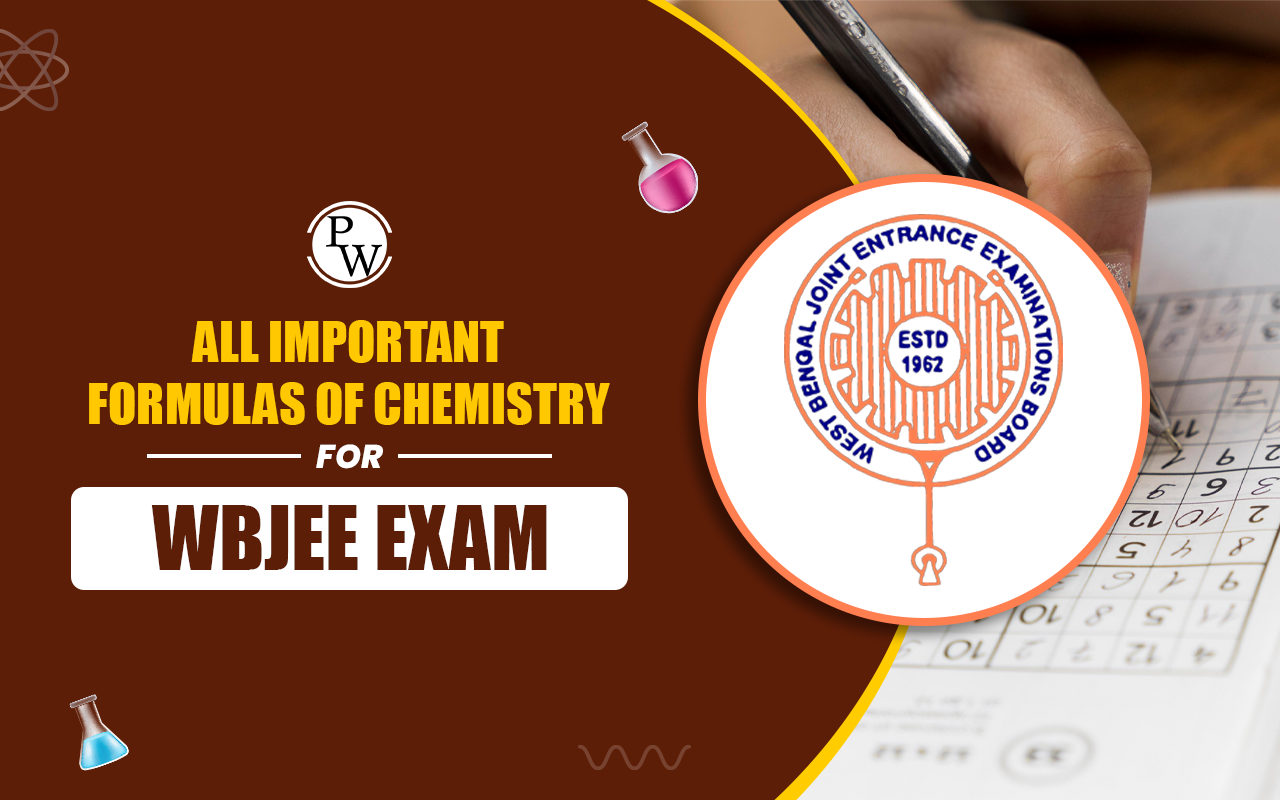

All Important Formulas of Chemistry for WBJEE Exam: Are you preparing for the WBJEE Exam? Having a complete list of essential Chemistry formulas can be a valuable tool for efficient revision and better performance. A well-organized formula sheet allows students to quickly access key formulas in Organic, Inorganic, and Physical Chemistry, saving time and improving problem-solving accuracy.
With all critical formulas at hand, students can focus more on understanding applications rather than recalling information under pressure. This organized formula sheet helps boost confidence and minimizes errors, making it an essential resource for success in the WBJEE Chemistry section. Below, we provide a comprehensive table with all the important formulas across the three sections of Chemistry.All Important Formulas of Chemistry for WBJEE Exam
This collection of essential Chemistry formulas covers key topics in Organic, Inorganic, and Physical Chemistry. Details are provided below to assist in efficient revision.| All Important Formulas of Chemistry for WBJEE Exam | |
|---|---|
| Topic | Formula/Description |
| Organic Chemistry | |
| General Formula for Alkanes | CnH2n+2 - Saturated hydrocarbons |
| General Formula for Alkenes | CnH2n - Unsaturated hydrocarbons with one double bond |
| General Formula for Alkynes | CnH2n-2 - Unsaturated hydrocarbons with one triple bond |
| Alcohol Functional Group | R-OH - Hydroxyl group attached to an alkyl chain |
| Aldehyde Functional Group | R-CHO - Carbonyl group at the end of an alkyl chain |
| Ketone Functional Group | R-CO-R' - Carbonyl group within an alkyl chain |
| Carboxylic Acid Functional Group | R-COOH - Carboxyl group attached to an alkyl chain |
| Ester Functional Group | R-COO-R' - Formed from the reaction between an acid and an alcohol |
| Amine Functional Group | R-NH2 - Contains a nitrogen atom bonded to alkyl groups |
| Amide Functional Group | R-CONH2 - Contains a carbonyl group bonded to a nitrogen atom |
| Inorganic Chemistry | |
| Periodic Trends | Atomic radius, ionization energy, and electronegativity vary across groups and periods |
| Molecular Orbital Theory | Bond order = (Number of bonding electrons - Number of antibonding electrons)/2 |
| Lewis Acids and Bases | Acid: electron pair acceptor, Base: electron pair donor |
| Coordination Compounds | Example: [Fe(CN)6]4- (hexacyanoferrate(II)) |
| Hardness of Water | Hardness (mg/L CaCO3) = (Mass of CaCO3 / Volume of water (L)) x 1000 |
| Equivalent Weight | Equivalent weight = Molar mass / Valency |
| Faraday’s Law of Electrolysis | m = (Q / F) x (M / n) - Mass (m) of a substance deposited during electrolysis |
| Physical Chemistry | |
| Mole Concept | n = m / M - Number of moles (n) equals mass (m) divided by molar mass (M) |
| Molarity (M) | M = n / V - Molarity is moles of solute per litre of solution |
| Normality (N) | N = Equivalent moles / V - Normality is equivalent moles of solute per litre of solution |
| Ideal Gas Law | PV = nRT - Relationship between pressure (P), volume (V), moles (n), gas constant (R), and temperature (T) |
| Boyle’s Law | P1V1 = P2V2 - Pressure is inversely proportional to volume for a given mass of gas at a constant temperature |
| Charles’s Law | V1 / T1 = V2 / T2 - The volume of a gas is directly proportional to its temperature at constant pressure |
| Raoult’s Law | Resolution = Xsolvent x Psolvent - Vapor pressure of a solution is proportional to the mole fraction of the solvent |
| pH and pOH | pH = -log[H+], pOH = -log[OH-], pH + pOH = 14 for aqueous solutions at 25°C |
| Nernst Equation | E = E0 - (0.0591 / n) log Q - Calculates cell potential under non-standard conditions |
| Gibbs Free Energy (ΔG) | ΔG = ΔH - TΔS and ΔG = -nFE - Relates enthalpy, temperature, and entropy; also Gibbs free energy to cell potential |
| Arrhenius Equation | k = A e^(-Ea / RT) - Describes the temperature dependence of reaction rates |
All Important Formulas of Chemistry for WBJEE Exam PDFs Download
Downloadable PDFs of all important Chemistry formulas are available to support WBJEE preparation. Access organized formula sheets for quick reference and better problem-solving. Detailed PDFs are given below.| All Important Formulas of Chemistry for WBJEE Exam PDFs Download | |
|---|---|
| Topic | Download Link |
| Organic Chemistry | Download Organic Chemistry Formulas |
| Inorganic Chemistry | Download Inorganic Chemistry Formulas |
| Physical Chemistry | Download Physical Chemistry Formulas |
How to Practice All Important Formulas of Chemistry for WBJEE Exam Preparation?
Understand Each Formula - Begin by understanding the meaning and context of each formula rather than memorizing it. Know what each variable represents, how it’s derived, and in which type of problems it’s used. This deep understanding will make application easier.
Group Formulas by Topic - Organize formulas into categories like Organic, Inorganic, and Physical Chemistry. Within these, group similar formulas together, like all thermodynamics formulas or chemical equilibrium formulas. This method helps with easier recall and builds connections between related formulas.
Apply in Practice Problems - Use the formulas in practice questions regularly. Solving problems reinforces the use of each formula, making it easier to remember them under exam pressure. Choose questions that require multi-step solutions, which will enhance your ability to use formulas effectively.
Practice Under Timed Conditions - Set up a timer when practicing problems, as the WBJEE is a time-limited exam. Working under time constraints improves your speed in recalling and using formulas correctly, helping you stay confident on exam day.
Revise Regularly - Revisit all formulas periodically, even if you feel you know them. Regular review strengthens retention and ensures that you don’t forget any formulas as the exam approaches.
All Important Formulas of Chemistry for WBJEE Exam FAQs
1. Why is it essential to have a comprehensive list of Chemistry formulas for the WBJEE exam?
2. Which key topics should be included in the Chemistry formula sheet for WBJEE?
3. How can I effectively memorize and use these formulas during the WBJEE exam?
4. Are there any recommended resources for obtaining a comprehensive Chemistry formula sheet tailored for WBJEE?
5. How often should I revise the Chemistry formulas to ensure retention for the WBJEE exam?












